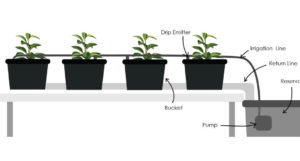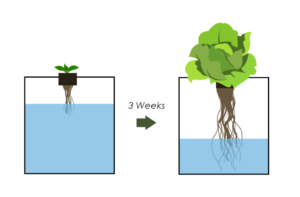Since our family eats so many vegetables, I decided to start growing our own. But conventional gardening has been nothing but continual frustration fighting fungus, disease, pests and nature. Originally, my research into hydroponic gardening was way back in 2002 before LED light technology. Without the cheap, excellent quality LED light sources available nowadays, hydroponics was just an alternative gimmick with no real advantages.
Fast-forward to 2017 when I began the search for better way to grow food at scale and kept coming back to hydroponics. With the technological advances in lighting, automation and fertilizer, hydroponics has now become similar to the cell phones vs. landlines debate. In fact, I would argue that for most crops, conventional farming is quite outdated.

Advantages of Hydroponics
All the annoying uncontrollable aspects of conventional farming disappear with hydroponics because you control the light source, wavelength, timing and intensity. You have complete control over the water temperature, ph level and nutrient level, and unlike conventional farming, hydroponics is also easily scalable. And all of this can be automated so your plants grow with minimal human interaction.
So to summarize: Conventional farming in raised beds, a garden or in a field must be cultivated, fertilized, watered and constantly monitored for pests and fungus. Hydroponics is totally automated to perform exactly the way that plants grow best. Indoor growing eliminates most pests and almost all fungus/mold.
Hydroponic Systems
Without getting too detailed, there are several types of hydroponics. Certain plants do better in certain systems, but you can use any of these systems to grow any plant.
Dutch Bucket
A reservoir pump runs specially formulated nutrient solution through a straight line over the buckets. Drippers control the flow to each bucket, and solution runs through the media in each bucket and then drains out of the bucket. It’s good for tomatoes and cucumbers. Example
Water Culture (floating raft)
The platform that holds the plants is usually made of Styrofoam and floats directly on the nutrient solution. An air pump supplies air to the air stone that bubbles the nutrient solution and supplies oxygen to the roots of the plants. It’s good for lettuces. Example
Ebb and Flow (flood and drain)
The Ebb and Flow system works by temporarily flooding the grow tray with nutrient solution and then draining the solution back into the reservoir. This action is normally done with a submerged pump that is connected to a timer. It’s good for root vegetables, onions and garlic. Example
Drip
A timer controls a submersed pump. The timer turns the pump on and the nutrient solution is dripped onto the base of each plant by a small drip line. In a Recovery Drip System, the excess nutrient solution that runs off is collected back in the reservoir for re-use. The Non-Recovery System does not collect the run off. It’s good for root vegetables, onions and garlic. Example
Nutrient Film Technique (NFT)
NFT systems have a constant flow of nutrient solution so no timer is required for the submersible pump. The nutrient solution is pumped into the growing tray (usually a tube), flowing over the roots of the plants, and then drains back into the reservoir. Example

Aeroponic: The roots hang in the air and are either misted with nutrient solution or nutrient water runs over the roots. The mistings are usually done every few minutes. Because the roots are exposed to the air like the NFT system, the roots will dry out rapidly if the misting cycles are interrupted. On a water-based system, the water runs over the exposed roots continuously. This offers the most oxygenation for plants. Example
Kratky Method
Plants sit above the water level and as the water level decreases, the roots of the plants grow longer to adapt. It’s the simplest and cheapest method–and is also becoming very popular.
Crops You Can’t Grow Hydroponically
Some crops such rice, tobacco, figs, watermelons, corn, grapes, citrus, apples and avocados, etc., don’t make sense to grow hydroponically because they are either too big, take up too much space or take too long to mature. The easiest crops to grow are herbs, lettuces, tomatoes, peppers, onions, garlic, cucumbers, peas, root vegetables, beans, strawberries and any other small vegetables.
Stay tuned for details about the hydroponics systems I use . . .







[…] If you missed my first post about hydroponics, be sure to read Hydroponics: Hassle-Free Gardening. […]
[…] case you’ve missed his posts (here and here), my husband is really into hydroponic gardening. Me? Well, I’m really into reaping […]
[…] case you’ve missed his posts (here and here), my husband is really into hydroponic gardening. Me? Well, I’m really into reaping […]